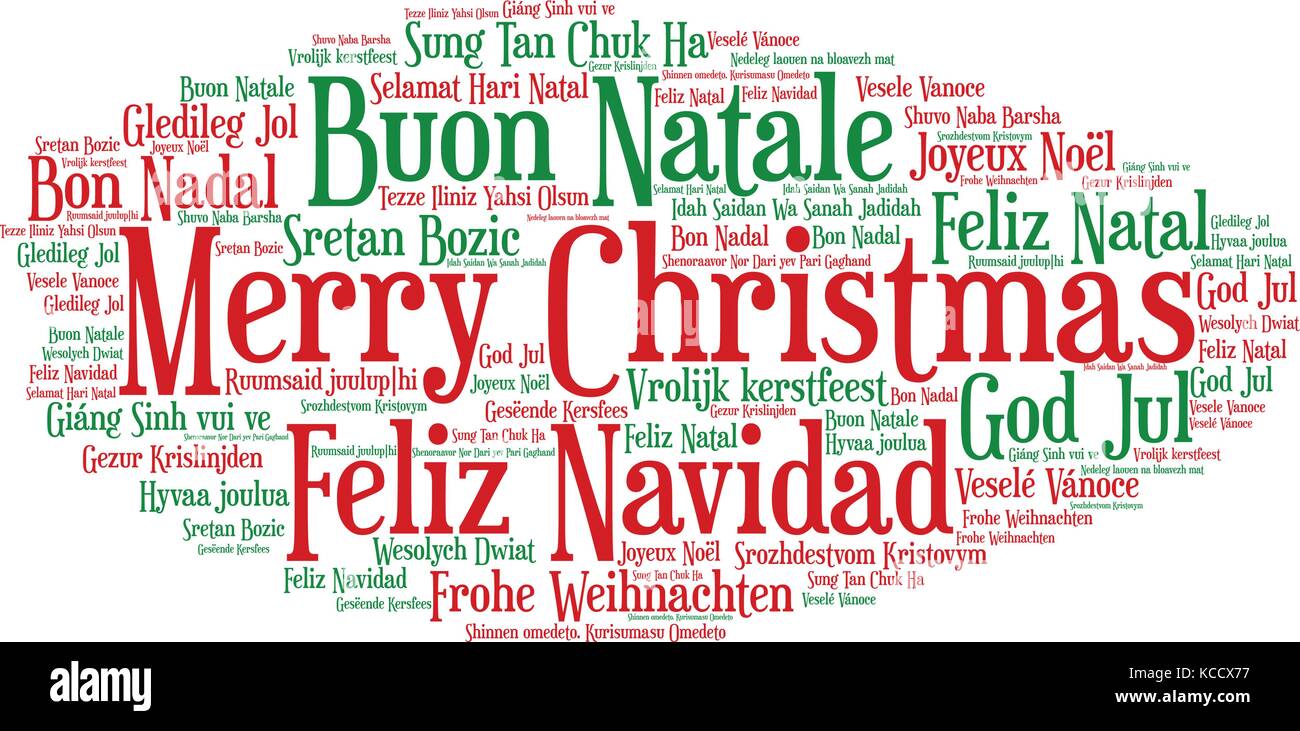Merry christmas in all languages – Merry Christmas, a phrase that echoes with joy and goodwill, transcends linguistic and cultural boundaries, uniting people worldwide in the spirit of celebration. This article embarks on a captivating journey to explore the diverse expressions of “Merry Christmas” in various languages and the rich cultural customs associated with its celebration.
From the origins of this cherished phrase to its regional variations and linguistic nuances, we delve into the tapestry of traditions, beliefs, and artistic expressions that make “Merry Christmas” a truly global phenomenon.
Language Translations

Merry Christmas is a joyous occasion celebrated worldwide, and each culture has its unique way of expressing this festive greeting. To foster inclusivity and global harmony, let’s embark on a linguistic journey and explore how “Merry Christmas” translates across different languages.
The following table provides a comprehensive listing of “Merry Christmas” translations in various languages, along with their respective countries and pronunciations (where available):
Table of Language Translations
| Language | Translation | Country | Pronunciation |
|---|---|---|---|
| English | Merry Christmas | United Kingdom, United States, Canada, Australia | /ˈmeri ˈkrɪsməs/ |
| Spanish | Feliz Navidad | Spain, Mexico, Argentina, Colombia | /feˈlis na.βiˈðað/ |
| French | Joyeux Noël | France, Canada, Belgium, Switzerland | /ʒwa.jø nɔ.ɛl/ |
| German | Frohe Weihnachten | Germany, Austria, Switzerland | /ˈfroːə ˈvaɪ.nax.tən/ |
| Italian | Buon Natale | Italy, Switzerland, San Marino, Vatican City | /ˈbwɔn naˈta.le/ |
| Portuguese | Feliz Natal | Brazil, Portugal, Angola, Mozambique | /feˈlis naˈtal/ |
| Chinese (Mandarin) | 圣诞快乐 | China, Taiwan, Singapore | /ʂɛŋ dàn kwài lè/ |
| Japanese | メリークリスマス | Japan | /me.ɾiː kuɾi.suma.su/ |
| Russian | С Рождеством Христовым! | Russia, Belarus, Ukraine | /s rɐʐ.dʲɪs.tvom xrʲɪ.ˈsto.vəm/ |
| Arabic | عيد ميلاد مجيد | Egypt, Saudi Arabia, United Arab Emirates | /ʕiːd miːlaːd maʒiːd/ |
Cultural Customs
Christmas, a globally celebrated holiday, is a rich tapestry of cultural customs that vary across the world. From traditional practices to vibrant decorations, delectable cuisines, and lively festivities, each region adds its unique flavor to this joyous occasion.
The diversity of Christmas customs is a testament to the cultural heritage and traditions of different societies. In many parts of the world, the holiday is associated with religious observances, such as attending church services and participating in nativity plays.
In other regions, it has evolved into a secular celebration, emphasizing family gatherings, gift-giving, and festive decorations.
Traditional Practices
Traditional practices associated with Christmas include:
- Midnight Mass:In many Christian communities, Midnight Mass is held on Christmas Eve, symbolizing the birth of Jesus Christ.
- Nativity Scenes:Depicting the birth of Jesus, nativity scenes are a common sight in homes and churches during the Christmas season.
- Caroling:Groups of singers go from house to house, spreading joy and Christmas cheer through carols.
Decorations
Christmas decorations are an integral part of the holiday’s festive atmosphere:
- Christmas Trees:Evergreen trees, adorned with lights, ornaments, and tinsel, are a popular symbol of Christmas.
- Wreaths:Circular wreaths made of greenery and decorated with ribbons and ornaments are often hung on doors or windows.
- Candy Canes:These red and white striped candies are a beloved Christmas treat and a common decoration.
Food, Merry christmas in all languages
Christmas is a time for indulging in delicious treats:
- Roast Turkey:A roasted turkey is a traditional centerpiece of Christmas dinner in many countries.
- Christmas Pudding:A rich, dried fruit pudding served with a brandy sauce is a classic Christmas dessert.
- Gingerbread Cookies:These festive cookies, often decorated with icing and sprinkles, are a popular treat during the holiday season.
Festivities
Christmas is celebrated with a variety of festivities:
- Christmas Markets:Open-air markets offering festive goods, food, and entertainment are a popular attraction in many European cities.
- Christmas Parades:Colorful parades featuring floats, marching bands, and Santa Claus are held in many towns and cities.
- Ice Skating:Outdoor ice skating rinks provide a fun and festive way to enjoy the winter season.
Historical Origins
The phrase “Merry Christmas” has a rich and storied history, tracing its roots back to ancient pagan winter solstice celebrations. The term “Merry” itself is derived from the Old English word “myrige,” meaning “joyful” or “pleasant,” while “Christmas” comes from the Old English “Cristes Maesse,” meaning “Christ’s Mass.”
In pre-Christian times, winter solstice festivals were celebrated throughout Europe, marking the shortest day of the year and the return of the sun. These celebrations were often accompanied by feasting, gift-giving, and merrymaking. With the spread of Christianity in the 4th century, these pagan traditions were gradually assimilated into the Christian celebration of Christ’s birth, which was officially established on December 25th by Pope Julius I.
Early Use of the Phrase
The earliest known written use of the phrase “Merry Christmas” appeared in a letter written by the English antiquarian John Aubrey in 1686. However, it is believed that the phrase was in common usage long before this date. In the 18th and 19th centuries, the phrase became increasingly popular, particularly in England and the United States, and it was often used in Christmas carols and festive greetings.
Global Spread and Significance
With the growth of global trade and travel in the 19th and 20th centuries, the phrase “Merry Christmas” spread to all corners of the world. Today, it is the most common Christmas greeting in English-speaking countries and is also widely used in many other languages.
In many cultures, the phrase has taken on a broader meaning, representing not only the Christian celebration of Christ’s birth but also the spirit of joy, goodwill, and generosity that is associated with the holiday season.
Regional Variations
The celebration of “Merry Christmas” varies significantly across different regions of the world, reflecting diverse cultural traditions, customs, and beliefs.
From the festive markets of Europe to the tropical beaches of Australia, each region has its own unique way of marking this special occasion.
Europe
In Europe, Christmas is a time for grand celebrations and family gatherings. The streets are adorned with twinkling lights and festive decorations, while Christmas markets offer a delightful array of traditional treats and handmade crafts.
In many European countries, such as Germany, Austria, and Poland, Christmas Eve is considered the main day of celebration, with families gathering for a traditional feast and exchanging gifts.
North America
In North America, Christmas is often associated with snowy landscapes, cozy fireplaces, and the iconic figure of Santa Claus. The festive season begins in early December with the decoration of Christmas trees and the exchange of Christmas cards.
On Christmas Eve, children eagerly hang their stockings by the fireplace, hoping for a visit from Santa Claus and his reindeer.
South America
In South America, Christmas is celebrated with a blend of Christian traditions and local indigenous customs. In many countries, such as Brazil, Colombia, and Peru, the Christmas season is marked by vibrant parades, colorful nativity scenes, and lively street parties.
Christmas Eve is often celebrated with a special mass, followed by a large family feast and the exchange of gifts.
Asia
In Asia, the celebration of Christmas varies widely depending on the country and its religious demographics. In countries with a strong Christian population, such as the Philippines and South Korea, Christmas is celebrated with religious services, festive decorations, and gift-giving.
In other Asian countries, such as China and Japan, Christmas is primarily a commercial event, marked by the exchange of gifts and the decoration of shopping malls and public spaces.
Australia
In Australia, Christmas falls during the summer months, making it a unique and festive experience. Australians often celebrate Christmas outdoors, with picnics, barbecues, and beach parties.
Christmas Eve is marked by a special church service, followed by a traditional dinner and the exchange of gifts.
Language Nuances

The phrase “Merry Christmas” exhibits linguistic nuances across different languages, reflecting cultural variations in grammar, syntax, and pronunciation.
Grammar and Syntax
In English, “Merry Christmas” is a noun phrase, while in many other languages, it is a verb phrase. For example, in Spanish, it is “Feliz Navidad,” where “Feliz” is an adjective and “Navidad” is a noun. This grammatical difference highlights the varying emphasis on the festive aspect of Christmas across cultures.
Pronunciation
The pronunciation of “Merry Christmas” varies significantly depending on the language. In English, the emphasis is on the second syllable (“Christ”), while in French, it is on the first syllable (“No”). These variations reflect the different phonetic systems and prosodic patterns of each language.
Cultural Differences
The linguistic nuances of “Merry Christmas” also reflect cultural differences in the way Christmas is celebrated. For instance, in some cultures, the phrase is used as a greeting during the entire Christmas season, while in others, it is only used on Christmas Day itself.
Social Impact: Merry Christmas In All Languages
The phrase “Merry Christmas” has a profound social impact, transcending its religious origins to become a symbol of community, goodwill, and cultural unity. Its usage fosters a sense of belonging, encourages acts of kindness, and bridges cultural divides, creating a shared experience that transcends differences.
During the Christmas season, communities come together in various ways to celebrate the spirit of the holiday. These celebrations often involve festive gatherings, gift exchanges, and charitable acts, promoting a sense of unity and goodwill among individuals. The phrase “Merry Christmas” serves as a common thread that connects people from diverse backgrounds, creating a shared sense of joy and celebration.
Fostering Community
- Christmas celebrations bring people together, creating a sense of community and belonging.
- Community events, such as Christmas markets, caroling, and tree lightings, provide opportunities for people to connect and share in the holiday spirit.
- The exchange of gifts and well wishes reinforces bonds between family, friends, and neighbors.
Promoting Goodwill
- “Merry Christmas” encourages acts of kindness and generosity.
- Christmas-themed charitable campaigns and volunteer initiatives promote a spirit of giving and helping those in need.
- The holiday season often inspires people to reflect on their own blessings and to extend compassion to others.
Bridging Cultural Divides
- “Merry Christmas” has become a widely recognized phrase, transcending religious and cultural boundaries.
- In many non-Christian countries, the phrase is used as a secular greeting during the holiday season.
- The shared experience of Christmas celebrations helps to foster understanding and appreciation among people from different cultures.
Artistic Expressions

The phrase “Merry Christmas” has inspired a vast array of artistic expressions, from classical paintings to modern sculptures, enchanting music to timeless literature. These artistic creations capture the spirit of the holiday, conveying its joy, hope, and goodwill.
Throughout history, renowned artists have found inspiration in the Christmas narrative, creating masterpieces that depict the nativity scene, the arrival of the Three Wise Men, and the joyous celebration of the holiday. One notable example is the painting “Adoration of the Magi” by Sandro Botticelli, which portrays the biblical story with exquisite detail and vibrant colors.
Paintings
Paintings inspired by “Merry Christmas” often depict traditional scenes of the holiday, such as the nativity, the Christmas tree, and the gathering of family and friends. These paintings evoke a sense of warmth, nostalgia, and the joy of the season.
- Nativity Scenes:These paintings depict the birth of Jesus in the manger, often surrounded by Mary, Joseph, shepherds, and animals. The Nativity scene is a central theme in Christian art and has been depicted by countless artists throughout history.
- Christmas Trees:Paintings of Christmas trees capture the festive spirit of the holiday. These paintings often depict decorated trees surrounded by gifts, ornaments, and twinkling lights.
- Family Gatherings:Paintings of family gatherings on Christmas day portray the joy and warmth of the holiday. These paintings often depict families gathered around a Christmas tree, exchanging gifts, or sharing a meal.
Sculptures
Sculptures inspired by “Merry Christmas” often depict the same scenes as paintings, but in three-dimensional form. These sculptures can be made from a variety of materials, such as wood, stone, metal, and glass.
- Nativity Scenes:Nativity scenes are also a popular subject for sculptors. These sculptures often depict the Holy Family in a manger, surrounded by shepherds, animals, and the Three Wise Men.
- Angels:Angels are another popular subject for Christmas sculptures. These sculptures often depict angels with wings, halos, and flowing robes.
- Santa Claus:Santa Claus is a popular figure in Christmas sculptures. These sculptures often depict Santa Claus with a red suit, white beard, and a sack full of toys.
Music
Music inspired by “Merry Christmas” includes carols, hymns, and popular songs. These songs often express the joy, hope, and goodwill of the holiday.
- Carols:Carols are traditional Christmas songs that are often sung by choirs or groups of people. Some of the most popular carols include “Silent Night,” “Joy to the World,” and “Hark! The Herald Angels Sing.”
- Hymns:Hymns are religious songs that are often sung in churches during Christmas services. Some of the most popular hymns include “O Come, All Ye Faithful,” “The First Noel,” and “Away in a Manger.”
- Popular Songs:Many popular songs have been written about Christmas. Some of the most popular Christmas songs include “White Christmas,” “Rockin’ Around the Christmas Tree,” and “Jingle Bell Rock.”
Literature
Literature inspired by “Merry Christmas” includes stories, poems, and plays. These works of literature often explore the themes of love, hope, and redemption.
- Stories:Many stories have been written about Christmas. Some of the most popular Christmas stories include “A Christmas Carol” by Charles Dickens, “The Gift of the Magi” by O. Henry, and “The Polar Express” by Chris Van Allsburg.
- Poems:Many poems have been written about Christmas. Some of the most popular Christmas poems include “Twas the Night Before Christmas” by Clement Clarke Moore, “A Visit from St. Nicholas” by Henry Livingston Jr., and “Stopping by Woods on a Snowy Evening” by Robert Frost.
- Plays:Many plays have been written about Christmas. Some of the most popular Christmas plays include “A Christmas Carol” by Charles Dickens, “The Nutcracker” by E.T.A. Hoffmann, and “It’s a Wonderful Life” by Frank Capra.
Cross-Cultural Connections
The celebration of Christmas has played a significant role in fostering cross-cultural connections and understanding.
One of the most notable examples of this is the exchange of Christmas traditions and customs between different cultures. For instance, the tradition of exchanging gifts, decorating Christmas trees, and singing Christmas carols has spread from Europe to many other parts of the world, becoming an integral part of local Christmas celebrations.
Cultural Exchange and Collaboration
Christmas has also been a catalyst for cultural exchange and collaboration, particularly in the realm of music and the arts. Many traditional Christmas songs and carols have been translated into different languages, allowing people from diverse backgrounds to share and enjoy the festive spirit.
Additionally, artists from different cultures have collaborated to create unique and innovative Christmas-themed works of art, music, and literature.
Fostering Understanding
The celebration of Christmas can also help to foster understanding and empathy between people from different cultures. By sharing in the joy and traditions of Christmas, people can gain a deeper appreciation for the diversity of human experiences and perspectives.
This can lead to greater tolerance, respect, and cooperation among people of all backgrounds.
Final Conclusion
In conclusion, “Merry Christmas” is not merely a seasonal greeting but a testament to the power of human connection and cultural exchange. As we navigate the complexities of language and tradition, we discover the universality of the Christmas spirit, which transcends borders and unites us in a shared celebration of joy, peace, and goodwill.
Q&A
What is the origin of the phrase “Merry Christmas”?
The phrase “Merry Christmas” traces its roots back to the 16th century, originating from the Middle English phrase “mirry Cristes masse,” meaning “joyful Christ’s mass.”
How is “Merry Christmas” celebrated differently around the world?
The celebration of Christmas varies significantly across cultures. In some regions, it is a religious festival, while in others, it has evolved into a more secular holiday. Traditions range from attending church services to exchanging gifts, decorating homes, and enjoying festive meals.
What are some linguistic nuances of “Merry Christmas” in different languages?
The translation of “Merry Christmas” into different languages reveals fascinating linguistic variations. In some languages, the phrase is a direct translation, while in others, it takes on unique forms and expressions, reflecting cultural and linguistic differences.